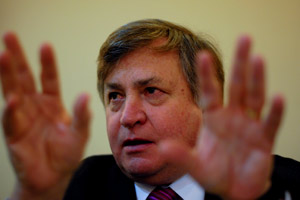
Flickr/jtyerse
Two billion dollars. That’s more than the GDPs of 46 of the world’s countries. More than the total value of exports of 96 countries. Forty thousand times greater than the US median household income.
It’s also the total amount of money House and Senate candidates are on track to raise this election season, with House races expected to drum up around $1.5 billion and Senate races $550 million. Or as the Washington Post put it today, that’s about $4 million for every seat in Congress up for grabs on November 2. And the $1.5 billion already raised by congressional candidates smashes the previous records in 2006 and 2008.
So where’s that money coming from, and who’s spending it? According to the Center for Responsive Politics, the top donors in 2010 include the usual big corporations and unions: AT&T ($3.3 million), International Brotherhood of Electrical Workers ($2.9 million), Boeing ($2.3 million), and the American Bankers Association ($2.3 million). Among the most expensive races are the Connecticut Senate showdown, pitting state attorney general Richard Blumenthal against former World Wrestling Entertainment executive Linda McMahon; the candidates have together raised more than $48 million, of which they’ve spent $44 million.
But the big story of the 2010 midterms, as Sid Mahanta and I point out today in a new MoJo video, is the massive fundraising and spending clout of shadowy outside groups that, under federal tax rules, don’t have to disclose their donors until well after Election Day—if ever. These secretive players, including group’s like the Karl Rove-backed Crossroads GPS and the American Future Fund, could spend upwards of $400 million by the time this election is over, cutting attack ads targeting candidates across the country.
Here’s more from the Post‘s Dan Eggen:
The surge is driven in part by the unusually broad battlefield in the House, where an estimated 90 seats are in play, almost all of them held by Democrats. Many Democratic incumbents are emptying their coffers in an attempt to win the message wars against GOP-allied interest groups.
“Both members of Congress and their challengers need to raise a huge amount of money to respond to these outside groups,” said David Donnelly, national campaigns director for the Public Campaign Action Fund, which advocates for public financing of elections. “Candidates are losing control of their elections unless they get on the phone to raise money to get their own ads on the air.”
Some of the most striking increases are evident on the House Republican side, where a deep bench of competitive candidates could wrest control of the chamber from Democrats. Republicans have also raised more and spent less, giving them an even larger advantage in the last week of the campaign. Through the third quarter of 2008, Democratic House candidates had outraised their opponents by $64 million. This year, the balance has been reversed, with Republicans outraising Democrats by $30 million, according to the action fund’s analysis, which is based on data from the Center for Responsive Politics.
GOP political consultants say the reasons for the shift are simple: Republican voters are more enthusiastic and they are eager to give money to challengers seeking to oust Democrats.















